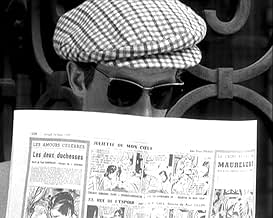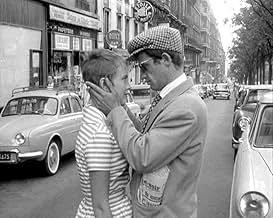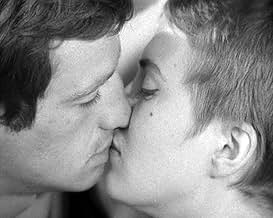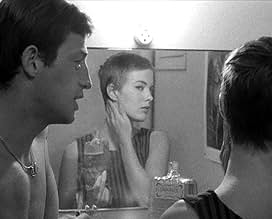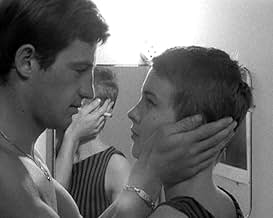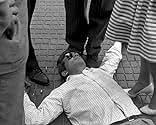A small-time crook, hunted by the authorities for a car theft and the murder of a police officer, attempts to persuade a hip American journalism student to run away with him to Italy.A small-time crook, hunted by the authorities for a car theft and the murder of a police officer, attempts to persuade a hip American journalism student to run away with him to Italy.A small-time crook, hunted by the authorities for a car theft and the murder of a police officer, attempts to persuade a hip American journalism student to run away with him to Italy.
- Director
- Writers
- Stars
- Nominated for 1 BAFTA Award
- 5 wins & 4 nominations total
Jean Seberg
- Patricia Franchini
- (uncredited)
Richard Balducci
- Tolmatchoff
- (uncredited)
Daniel Boulanger
- Police Inspector Vital
- (uncredited)
Gérard Brach
- Photographer
- (uncredited)
Philippe de Broca
- A Journalist
- (uncredited)
José Bénazéraf
- Man in a White Car
- (uncredited)
Jean Domarchi
- A Drunk
- (uncredited)
Jean Douchet
- A Journalist
- (uncredited)
Liliane Dreyfus
- Liliane
- (uncredited)
- …
Michel Fabre
- Police Inspector #2
- (uncredited)
Jean-Luc Godard
- The Snitch
- (uncredited)
Roger Hanin
- Carl Zubart
- (uncredited)
Henri-Jacques Huet
- Antonio Berrutti
- (uncredited)
Raymond Huntley
- A Journalist
- (uncredited)
André S. Labarthe
- Journalist at Orly
- (uncredited)
- Director
- Writers
- All cast & crew
- Production, box office & more at IMDbPro
Featured reviews
Jean-Luc Godard's, A Bout de Souffle is possibly the brightest star to shine from the French New Wave. The 'Nouvelle Vague' came about from a group of like minded film critics writing for the Cahiers du Cinema.
With his knowledge of classic film narrative and style Godard went out to create his own film in homage to, and also complete contradiction to, classic Hollywood film.
The plot reads almost like a crime thriller typical of the 1930-40's. A criminal on the run from the police; the distraction of a beautiful woman; the escape and eventually someones death. But it is in Godard's approach to film style and use of new technologies that the typical crime thriller was turned on its head.
In a break from classic Hollywood narrative the film opens with little equilibrium. Our protagonist's motives are unclear as he tears off to Paris leaving a woman and a dead cop in his trail. This in turn makes the ending somewhat open ended. With no sense of equilibrium to start with how can there be closure on what has happened throughout the film.
Another twist on the classic storytelling in film is the progression of plot. It is naturally assumed in classic Hollywood film, that everything the spectator sees they see for a reason. With Michel's constantly pointless phone calls to retrieve owed money the plot is not pushed along at all. The inclusion of a 25 minute digression from the plot stands to emphasise the spectators reliance on narrative structure in the watching of films. Although watching the film closely is, as always, important in following the story A Bout de Souffle requires that little bit extra to define where the plot is being progressed and where Michel or Patricia are just flattering their egos or each other.
All in all I personally think that A Bout de Souffle brought about a sense of realism not seen in Hollywood cinema before 1959 and even now. The fact that life isn't full of clues that will help us progress in say our relationships or escape from authority, but is infact full of digression; self exploration; and the confusions of love, ego and aspirations.
With his knowledge of classic film narrative and style Godard went out to create his own film in homage to, and also complete contradiction to, classic Hollywood film.
The plot reads almost like a crime thriller typical of the 1930-40's. A criminal on the run from the police; the distraction of a beautiful woman; the escape and eventually someones death. But it is in Godard's approach to film style and use of new technologies that the typical crime thriller was turned on its head.
In a break from classic Hollywood narrative the film opens with little equilibrium. Our protagonist's motives are unclear as he tears off to Paris leaving a woman and a dead cop in his trail. This in turn makes the ending somewhat open ended. With no sense of equilibrium to start with how can there be closure on what has happened throughout the film.
Another twist on the classic storytelling in film is the progression of plot. It is naturally assumed in classic Hollywood film, that everything the spectator sees they see for a reason. With Michel's constantly pointless phone calls to retrieve owed money the plot is not pushed along at all. The inclusion of a 25 minute digression from the plot stands to emphasise the spectators reliance on narrative structure in the watching of films. Although watching the film closely is, as always, important in following the story A Bout de Souffle requires that little bit extra to define where the plot is being progressed and where Michel or Patricia are just flattering their egos or each other.
All in all I personally think that A Bout de Souffle brought about a sense of realism not seen in Hollywood cinema before 1959 and even now. The fact that life isn't full of clues that will help us progress in say our relationships or escape from authority, but is infact full of digression; self exploration; and the confusions of love, ego and aspirations.
10IZMatt
I don't blame those who state that they do not "understand" the superlatives surrounding Jean-Luc Godard's 1960 masterpiece, Breathless. It's primarily because to appreciate Breathless, one has to view the movie from a historical context, which also requires studying of not only the French New Wave, but film theories as a whole, and the lives of those apart of the New Wave. Breathless accomplished many things unprecedented prior (many completely unprecedented, but some things are not-so-much).
Roger Ebert put it best when he said that just as film fanatics may now stand outside a movie theatre waiting for the next Quentin Tarantino movie to be released, film enthusiasts were doing so for Godard in the 1960s. He was a revolutionary, which is why MovieMaker magazine called him the 4th most influential director of ALL-TIME (only behind Welles, Griffith, and Hitchcock)! What did Godard do different? Breathless is all style, simple as that. The story line is interesting, yes, but is Godard's aesthetics, production modes, subject matters, and storytelling methods that are key. First of all, the whole movie was shot on a hand-held camera, just like most all New Wave pictures. It was, however, only shot by two people (Godard and his cinematographer, Rouald) on a budget that did not top $50,000, a mere fraction of what most pictures cost at the time (another facet of the New Wave). It was shot completely on location in Paris, and utilized new film-making techniques that would be used by film-making students for decades to come (such as putting the camera in a mail cart on the Champs Elysees and following Belmondo and Seberg). Note Godard's use of American cinema influence, and how the montage art of the 1950s impacted this aesthetic.
(A brief New Wave lesson: Most New Wave directors were displeased with the "tradition of quality," or the older generation directors who, as Truffaut put it, made the "twelve or so" pictures per year that represented France at Venice and Cannes. Most of these pictures classic or modern literary adaptations, completely stagnant in artistic quality with rehashed subject matters based on historical periods. New Wave directors supported NEW tales of modern Parisian life, primarily, and were sick of the themes found in the tradition of quality films.) The storytelling methods in Breathless are perhaps the most fascinating part of the film. The jump cuts may seem lame, but one must again view them from a historical context: it had never been done before. This is exactly why Breathless is important -- practically every technique was revolutionary. They are so submerged into film-making practices now that Breathless seems typical. Yet at the time, it was, as I said prior, unprecedented.
Roger Ebert put it best when he said that just as film fanatics may now stand outside a movie theatre waiting for the next Quentin Tarantino movie to be released, film enthusiasts were doing so for Godard in the 1960s. He was a revolutionary, which is why MovieMaker magazine called him the 4th most influential director of ALL-TIME (only behind Welles, Griffith, and Hitchcock)! What did Godard do different? Breathless is all style, simple as that. The story line is interesting, yes, but is Godard's aesthetics, production modes, subject matters, and storytelling methods that are key. First of all, the whole movie was shot on a hand-held camera, just like most all New Wave pictures. It was, however, only shot by two people (Godard and his cinematographer, Rouald) on a budget that did not top $50,000, a mere fraction of what most pictures cost at the time (another facet of the New Wave). It was shot completely on location in Paris, and utilized new film-making techniques that would be used by film-making students for decades to come (such as putting the camera in a mail cart on the Champs Elysees and following Belmondo and Seberg). Note Godard's use of American cinema influence, and how the montage art of the 1950s impacted this aesthetic.
(A brief New Wave lesson: Most New Wave directors were displeased with the "tradition of quality," or the older generation directors who, as Truffaut put it, made the "twelve or so" pictures per year that represented France at Venice and Cannes. Most of these pictures classic or modern literary adaptations, completely stagnant in artistic quality with rehashed subject matters based on historical periods. New Wave directors supported NEW tales of modern Parisian life, primarily, and were sick of the themes found in the tradition of quality films.) The storytelling methods in Breathless are perhaps the most fascinating part of the film. The jump cuts may seem lame, but one must again view them from a historical context: it had never been done before. This is exactly why Breathless is important -- practically every technique was revolutionary. They are so submerged into film-making practices now that Breathless seems typical. Yet at the time, it was, as I said prior, unprecedented.
I finally did it. I finished watching À bout de souffle. I kept putting it off because I usually have problem when everybody tells me that such and such film is the epitome of its era or it breaks all the rules, starts the revolution, and reinvents the cinema. That's why, probably, I cannot like Citizen Kane - try to watch the arguably best film ever made - you will be under a lot of pressure.
Well, À bout de souffle does not put you under the pressure, it takes you for a ride, and you follow for 90 minutes its incredibly young characters, common crook (Jean-Paul Belmondo) and his American free-spirited girlfriend (Jean Seberg) on their journey on the streets of 1960-th Paris along with Raoul Coutard's legendary camera. I am not going to tell here how great the camera work was, how fantastic the music score and the views of Paris were - the fans of the film know that already. They also know about the beginning of French New Wave, and how it influenced the future cinema. I just want to say that the movie was made over forty years ago - the smoking was cool back then, and Belmondo made smoking look very sexy. Belmondo fascinates me in this film. I've seen him in a lot of later movies - he's always been good (I recommend Le Magnifique, 1973 and Le Professionnel,1981 ) - but in À bout de souffle he is not just good - he is embodiment of cool, his face changes its expression every moment, you can not take your eyes off him. Is it me or he does remind the very young Mick Jagger - not commonly handsome but irresistible and sexy? He and young (she was 21 at the time) Jean Seaborg made one of the best screen couples ever. My favorite scenes:
Michel drives the stolen car in the beginning of the film, and he starts to talk to us, the audience. The day is nice, the sun is shining, and the life is beautiful...
Michel and Patricia drive in the convertible. The wind plays with her short hair. We only see the back of her head and her neck. Michel tells her that he loves the girl with a beautiful neck, wrists, knees, but she is a chicken...
Patricia comes to the hotel to find Michel in her bed. They start talking about nothing and about very serious things. They smoke, she tries to find a good place for her new poster, and he wants to sleep with her. In the end of the scene, his face, he looks at her - there is love in that look...
There is more - I am sure everyone who saw it has his/her favorite scenes.
Well, À bout de souffle does not put you under the pressure, it takes you for a ride, and you follow for 90 minutes its incredibly young characters, common crook (Jean-Paul Belmondo) and his American free-spirited girlfriend (Jean Seberg) on their journey on the streets of 1960-th Paris along with Raoul Coutard's legendary camera. I am not going to tell here how great the camera work was, how fantastic the music score and the views of Paris were - the fans of the film know that already. They also know about the beginning of French New Wave, and how it influenced the future cinema. I just want to say that the movie was made over forty years ago - the smoking was cool back then, and Belmondo made smoking look very sexy. Belmondo fascinates me in this film. I've seen him in a lot of later movies - he's always been good (I recommend Le Magnifique, 1973 and Le Professionnel,1981 ) - but in À bout de souffle he is not just good - he is embodiment of cool, his face changes its expression every moment, you can not take your eyes off him. Is it me or he does remind the very young Mick Jagger - not commonly handsome but irresistible and sexy? He and young (she was 21 at the time) Jean Seaborg made one of the best screen couples ever. My favorite scenes:
Michel drives the stolen car in the beginning of the film, and he starts to talk to us, the audience. The day is nice, the sun is shining, and the life is beautiful...
Michel and Patricia drive in the convertible. The wind plays with her short hair. We only see the back of her head and her neck. Michel tells her that he loves the girl with a beautiful neck, wrists, knees, but she is a chicken...
Patricia comes to the hotel to find Michel in her bed. They start talking about nothing and about very serious things. They smoke, she tries to find a good place for her new poster, and he wants to sleep with her. In the end of the scene, his face, he looks at her - there is love in that look...
There is more - I am sure everyone who saw it has his/her favorite scenes.
This is the one that started it all kids, the daddy of post-modern cinema. MTV jump cuts, fractured soundtrack and images aplenty
Self reflexive to the point that it not only acknowledges its own existence, it revels in it.
All style and no substance is considered a bad thing today, unless its Tarantino. Well, if it wasn't for Godard, chances are there would be no QT.
All the characters and images, and dialogue and sets are constructed from all aspects of life - Michel is a Bogart collage. Patricia apes everything she sees, from her Interviewee's facial gestures to Michel's own.
Don't let all this technical mumbo fool you, I did my thesis on Godard and would happily bore the ass off you with a lecture in great detail about this film, but the fact is, it's a stormer.
Grips you by the throat and shakes the hell out of you, and it doesn't let go until the final breath.
Fantastically, artistically magnificent. If Godard wanted to make his debut picture to show how well he understood American ideals and the history of cinema, he couldn't have made a better picture.
Top stuff French guy.
Self reflexive to the point that it not only acknowledges its own existence, it revels in it.
All style and no substance is considered a bad thing today, unless its Tarantino. Well, if it wasn't for Godard, chances are there would be no QT.
All the characters and images, and dialogue and sets are constructed from all aspects of life - Michel is a Bogart collage. Patricia apes everything she sees, from her Interviewee's facial gestures to Michel's own.
Don't let all this technical mumbo fool you, I did my thesis on Godard and would happily bore the ass off you with a lecture in great detail about this film, but the fact is, it's a stormer.
Grips you by the throat and shakes the hell out of you, and it doesn't let go until the final breath.
Fantastically, artistically magnificent. If Godard wanted to make his debut picture to show how well he understood American ideals and the history of cinema, he couldn't have made a better picture.
Top stuff French guy.
So says the novelist in response to Patricia's question, "What do you hope to attain out of life?" That response is the philosophy of the film and of every character in the film. All want to be in control of their destiny. All want to be something that they are not. None are able to do any of these things. They are all contradictions. How can you die as an immortal? How can Patricia be free and independent is so many other things determine what she can do? How can this film transcend the screen while existing on the screen? This is an amazing film to watch. Goddard fills every scene with ingenuity and energy. He puts his actors in a beautiful environment and lets them do their thing. And they do it extremely well. The actors are beautiful. Not just cosmetically, but spiritually and psychologically. I am not sure that I liked either of the two main characters. I am sure I could not keep my eyes off them. I could not take my eyes off the screen. Techniques that novices today use for no substantial purpose are utilized by Goddard to amazing effect. The greatest filmmakers are the great editors. Goddard makes the editing a character itself. It is the nervous narrator hurrying the film along. It breathlessly awaits the next scene, and leads us to do the same. I like the way Goddard spends prodigious time simply watching his characters. The conversation scene at the center of the film is amazingly long and drawn out, yet I did not find it boring. I found it fascinating. People are fascinating. Everyone is trying to be something. It takes tremendous talent to indulge in the minutiae of existence. A great film.
Did you know
- TriviaDespite reports to the contrary, Jean-Luc Godard did not shoot the film without a script; however, he did not have a finished script at the beginning, instead writing scenes in the morning and filming them that day. See also Pierrot le fou (1965).
- GoofsDuring street shots, countless passersby look at Patricia and Michel and stare into the camera, revealing that the shots were made without filming barriers and simply used street pedestrians in place of extras.
- Quotes
Patricia Franchini: What is your greatest ambition in life?
Parvulesco: To become immortal... and then die.
- ConnectionsEdited into Pariz pripada nama! (2016)
Details
- Release date
- Country of origin
- Languages
- Also known as
- Sin aliento
- Filming locations
- 11 rue Campagne Première, Paris 14, Paris, France(on location)
- Production companies
- See more company credits at IMDbPro
Box office
- Budget
- FRF 400,000 (estimated)
- Gross US & Canada
- $414,173
- Opening weekend US & Canada
- $32,424
- May 30, 2010
- Gross worldwide
- $594,039
- Runtime1 hour 30 minutes
- Sound mix
- Aspect ratio
- 1.37 : 1
Contribute to this page
Suggest an edit or add missing content






